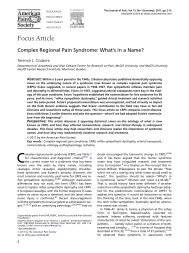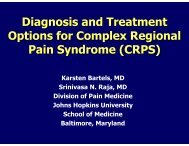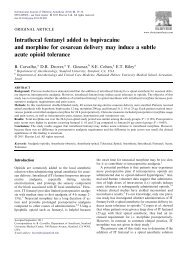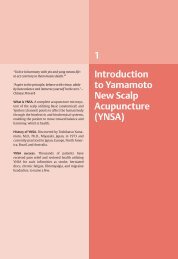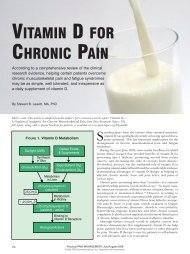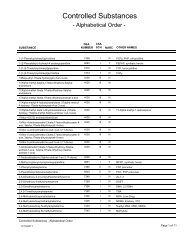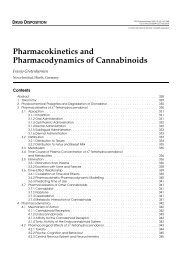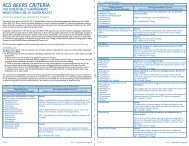GLIA: A NOVEL DRUG DISCOVERY TARGET FOR CLINICAL PAIN
GLIA: A NOVEL DRUG DISCOVERY TARGET FOR CLINICAL PAIN
GLIA: A NOVEL DRUG DISCOVERY TARGET FOR CLINICAL PAIN
Create successful ePaper yourself
Turn your PDF publications into a flip-book with our unique Google optimized e-Paper software.
REVIEWS<strong>GLIA</strong>L FIBRILLARY ACIDICPROTEIN(GFAP). An astrocyte-specificprotein. Increases in GFAP arefrequently used as a marker ofastrocyte activation.p38 MAP KINASEAn intracellular signallingcascade, activated in responseto pro-inflammatory cytokinereceptor binding. Activation ofthis cascade leads to productionof pro-inflammatorycytokines.astrocytes within the spinal cord. This review will firstexamine the evidence that activated glia drive the creationand maintenance of allodynia and hyperalgesia. Thisliterature review will demonstrate that astrocytes andmicroglia in the spinal cord must now be recognized asactive participants in the creation and maintenance ofpain facilitation induced by inflammation and damageto peripheral tissues, peripheral nerves, spinal nervesand the spinal cord. On activation, these glia release avariety of neuroexcitatory substances that potentiatepain transmission by neurons. Of these glial products,pro-inflammatory cytokines will be shown to be commonspinal mediators of allodynia and hyperalgesia.Given the failure of presently available drugs to provideadequate clinical pain management, this newly recognizedrole of glia in general, and pro-inflammatorycytokines in particular, is exciting because it predictsnovel approaches for effective pain control by targetingglial activation.A number of drugs will be introduced in the courseof this discussion that are effective in controlling gliallydriven exaggerated nociceptive states in laboratoryanimals. Each of these drugs will be discussed in thefinal section of this review, with regard to their potentialclinical application.What does it mean that glia are ‘activated’?In the following discussion, frequent reference will bemade to ‘activated’ glia. Activation is a fundamentallydifferent phenomenon in neurons compared with thatin glia. The term ‘activation’ refers to an enhanced abilityof a cell to perform a function beyond that present in abasal state. For neurons, activation is unidimensional, asit mainly relates to the production of action potentials.By contrast, activation of glia is multi-dimensionalbecause glia perform numerous functions (see below).So there are many different activational states, with variouscomponents expressed with different time-coursesand intensities that are dependent on the stimulus thattriggers activation.Astrocytes are basally active in carrying out a numberof functions, but unless there is an external stimulusthey do not become activated. Astrocytes serve severalfunctions in the normal central nervous system (CNS),including the regulation of: extracellular ion and neurotransmitterconcentrations; the availability of neurotransmitter/neuromodulatorprecursors to nearbyneurons; and extracellular pH. No evidence is apparentin the literature that these functions are regulated bystimuli that activate astrocytes or by substances releasedby activated glia. As such, they do not seem likely to beaffected by drugs that target these aspects of activatedastrocyte function.Astrocyte activation occurs in response to CNStrauma, ischaemia, tumours, neurodegeneration, andthe presence of immunogenic components of virusesand bacteria 5 .Activation is morphologically characterizedby hypertrophy and increased production of intermediatefilaments (<strong>GLIA</strong>L FIBRILLARY ACIDIC PROTEIN (GFAP),vimentin and/or nestin) 5 , and functionally by increasedproduction of a variety of pro-inflammatory substances 6 .Notably, functional changes and morphologicalchanges are not time-locked, so functional changescan be detected in the absence of increased intermediatefilaments, and vice versa.In contrast to astrocytes, microglia in the normalCNS are quiescent cells with no recognized function 7 .In this state, they exhibit a ramified morphology, noactivation of p38 MITOGEN-ACTIVATED PROTEIN (MAP) KINASE,and little or no expression of the receptors, cellsurfacemarkers or functional activities characteristicof activated microglia 7 .Microglial activation occurs in response to the samerange of stimuli that activate astrocytes. It is a gradedphenomenon, characterized by a specific morphology(retracted processes and hypertrophy; amoeboid morphologyunder strongly pathological circumstances),proliferation, increased expression of one or more cellsurfacemarkers or receptors (such as the complement 3receptor associated with adhesion, migration andphagocytosis and scavenger receptors associated withphagocytosis), and/or changes in functional activities(migration to areas of damage, phagocytosis, production/releaseof pro-inflammatory substances) 7 .Notably,the changes in receptors, cell-surface markers and/or theproduction of pro-inflammatory substances can occurin the absence of morphological changes, proliferationor phagocytosis 7,8 .So, as is the the case for astrocyteactivation, microglial activation is a multi-dimensionalprocess. The manner in which activation is expressed isdependent on the type and intensity of the inductivestimulus, and different patterns and time-courses ofresponses can occur.Spinal cord glia as powerful modulators of painUntil recently, glia were thought of simply as housekeepersfor neurons, regulating the extracellular ionicenvironment and removing debris. However, in recentyears it has become recognized that glia dynamicallymodulate the function of neurons under both physiologicaland pathological conditions 9 .In the discussion to follow, the term ‘glia’ will be usedto refer to both microglia and astrocytes. As will bereviewed below, both cell types are activated in thespinal cord in response to experimental manipulationsthat induce pain facilitation. Both cell types, on activation,can produce and release a variety of nociceptionenhancingsubstances. In addition, each stimulates thefurther activation of the other, perhaps forming afunctional unit. The use of the term ‘glia’ in the presentcontext reflects the fact that most presently availabledata support the notion that both microglia andastrocytes are involved in allodynia and hyperalgesia,but that these data cannot yet allow us to determine therelative contributions of each.Glia first came to the attention of pain researchersin the early 1990s when Garrison et al. reported thatperipheral nerve damage that created exaggerated nociceptiveresponses (neuropathic ‘pain’ behaviours) alsoactivated spinal cord glia (FIG. 2).Furthermore, theN-methyl-D-aspartate (NMDA) antagonist MK801,which blocks neuropathy induced allodynia andNATURE REVIEWS | <strong>DRUG</strong> <strong>DISCOVERY</strong> VOLUME 2 | DECEMBER 2003 | 975



